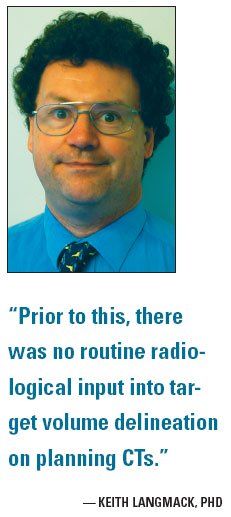Virtual communication enhances RT treatment planning
New soft ware facilitates better collaboration between oncologists and radiologists on imaging reports, according to UK-based researchers, most notably by connecting physicians who are geographically separated.
ABSTRACT: UK-based radiation specialistsopen the lines of communicationbetween oncologists, radiologists.
New soft ware facilitates better collaboration between oncologists and radiologists on imaging reports, according to UK-based researchers, most notably by connecting physicians who are geographically separated.

Keith Langmack, PhD, and colleagues from the department of radiotherapy physics at Nottingham University Hospitals used Microsoft NetMeeting, along with a commercial virtual simulator package (Pro- Soma), to facilitate communication between the radiology and oncology departments (Br J Radiol 81:666-667, 2008).
The Royal College of Radiologists has recommended that clinical oncologists and radiologists collaborate closely on gross tumor delineation in complex cases, but doing so is not as easy as it sounds. Problems arise when departments are far apart or PACS workstations cannot accommodate certain images, according to Dr. Langmack’s group.
He said Nottingham University hospitals’ cancer center is split over two main sites that are five miles apart and joined by a congested ring road, making in-person meetings difficult. One hospital provides the radiotherapy service, while the radiologists are housed in the other building. In addition, the PACS does not support tumor outlining or provide image fusion capability.
To address the distance problems, Dr. Langmack’s team employed the remote desktop application that is part of the standard Microsoft Windows package. The program allows two or more users to share applications and data as well as to videoconference across a network connection. They also used the commercial ProSoma PC-based virtual package to aid in target volume delineation over the hospital network.
“The advantage of this is that the interacting clinicians do not have to be present at the same place, hence eliminating traveling time and allowing clinicians to consult in a very efficient manner,” the group wrote.
The authors explained how the setup works: An oncologist runs NetMeeting on the virtual simulation workstation while the radiologist opens NetMeeting on a PC. The oncologist starts the session by entering the Internet protocol address of the radiologist’s PC into his or her system. The radiologist then accepts the session. Once the connection is established, the oncologist can share the desktop in full-color mode. Each participant can see fused image sets and can delineate the gross tumor volume or other structures.
Access is not one-sided, however. When the radiologist wants to control the virtual stimulation, a request is relayed almost instantaneously to the oncologist, according to Dr. Langmack.
Since the inception of NetMeeting and ProSoma, communication between radiologists and oncologists has increased signifi cantly, he said.
“Over the six months that we have been using NetMeeting and ProSoma, our specialist head and neck oncologists and radiologists have been working together on planning CTs approximately once a month on difficult cases,” Dr. Langmack wrote. “Prior to this, there was no routine radiological input into target volume delineation on planning CTs.”
Dr. Langmack added that NetMeeting allows interaction among multiple users, so complex cases can have input from several colleagues. A secure network link makes it possible to consult colleagues in remote institutions on difficult cases, Dr. Langmack said.
“It could also be used during the quality assurance phase of clinical trials for participants to discuss the delineation of tumors,” he said.
Targeted Therapy First Strategy Reduces Need for Chemotherapy in Newly Diagnosed LBCL
December 7th 2025Lenalidomide, tafasitamab, rituximab, and acalabrutinib alone may allow 57% of patients with newly diagnosed LBCL to receive less than the standard number of chemotherapy cycles without compromising curative potential.